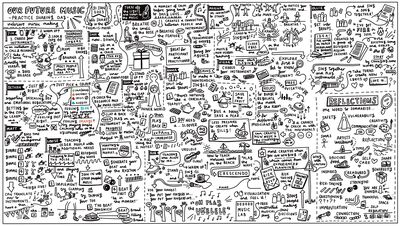
In January 2023 practitioners from Create Music, Kent Music, Surrey Music Hub and West Sussex Music came together for a practice-sharing day.
Everyone shared an example of an activity that could be used in a creative, inclusive music session, which were recorded and can be watched here:
Musician and teacher, Rob, demonstrated inclusive whole-class involvement in music-making by exploring the relationship between creativity and structure; and fostering children's spirit and energy. His warm-up uses spelling, body parts, shared leadership, prepositions, call and response, 1980s party songs and wordplay! The group identified the use of fun and silly music-making to teach musical concepts and language, and develop a love of group music-making.
Creative practitioners Sara and Marina lead a guided musical meditation using visualisation. This technique is being used with displaced communities and young people with additional needs to promote self-regulation of the nervous system. The group notice its use as an 'energy changer' for young people and vulnerable adults who need support in feeling calm.
Music teacher Rania supports participants in creating nonsense jingles in small groups using whatever instrumentation is available to them. The technique uses words and story-telling to encourage self-expression and group music-making in a variety of settings.
Creative practitioner Marina lead a vocally-led group music-making activity; demonstrating the use of visual cues. This technique requires the body's own instruments only - voice and body percussion and Marina demonstrates it using songs originating from **. Participants address texture, dynamics, pitch and rhythm through an inclusive style of leadership.
Musician and practitioner John promotes improvisation and composition through a variety of strategies including call and response, and passing the leadership. He supports participants to improvise and compose safely in a bite-sized way to create a whole group piece of music with everyone taking part.
Music teacher Vieda uses exploration of sound for all participants to combine old and new sounds to compose together as a group. She uses a personalised approach with each participant within the group alongside her clear leadership to enable participants to feel confident to increase their exploration through pitch, rhythm, texture, dynamics and pulse, resulting in a party piece!
Inclusive music practitioner, Matt, shares rhythmic game 'Gimme 5' applicable to many group music-making contexts. The group discuss its use with children and young people with profound additional needs, school-based whole-class, displaced communities, to name a few; and how to create variations of games based on the group they are working with. The warm-up game can use voice and body percussion or instrumentation; and focuses on listening, sense of ensemble, sharing leadership to enable to development of music-making skills.
Singer-songwriter artist, Ollie, supports participants in sharing self-expression through teaching and performing a song as a group. Ollie explains how he has used his developed understanding of community and cultural songs to support young people in writing song lyrics. He uses games, competition and his understanding of human energy and motivation to support young people to connect words to write a song. These techniques are being used with refugees and asylum seekers and young people not in education or training.
Music teacher Bethan demonstrates how to use the Just Right strategy to support sensory and emotional regulation for young people with autism. It uses scaling and colour coding to support children and young people to get into the 'right' zone for learning.
Leader and practitioner Jim demonstrates the use of listening and non-verbal invitation for group music-making that has been used in a highly inclusive way. The group consider its use with relevance to culture, displaced communities, high-secure units, physical disability and for those who don't have a shared language.